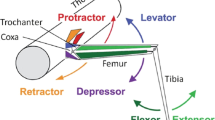Abstract
As in the preceding paper stick insects walk on a treadwheel and different legs are put on platforms fixed relative to the insect's body. The movement of the walking legs is recorded in addition to the force oscillations of the standing legs. The coordination between the different legs depends upon the number and arrangement of the walking legs and the legs standing on platforms. In most experimental situations one finds a coordination which is different from that of a normal walking animal.
Similar content being viewed by others
References
Batschelet, E.: Statistical methods for the analysis of problems in animal orieutation. An. Inst. Biol. Sc. (1965)
Bässler, U.: Sensory control of leg movement in the stick insect Carausius morosus. Biol. Cybernetics 25, 61–72 (1977)
Bässler, U.: Interaction of peripheral and central mechanisms during walking in the 1st instar Extatosoma tiaratum. Physiol. Entomol. 4, 193–199 (1979)
Cruse, H.: A new model describing the coordination pattern of the legs of a walking stick insect. Biol. Cybernetics 32, 107–113 (1979)
Cruse, H.: A quantitative model of walking incorporating central and peripheral influences. I. The control of the individual leg. Biol. Cybernetics (in press) (1980a)
Cruse, H.: A quantitative model of walking incorporating central and peripheral influences. II. The connections between the different legs. Biol. Cybernetics (in press) (1980b)
Cruse, H., Saxler, G.: Oscillation of force in the standing legs of a walking insect (Carausius morosus). Biol. Cybernetics 36, 159–163 (1980)
Graham, D.: A behavioural analysis of the temporal organization of walking movements in the 1st instar and adult stick insect (Carausius morosus). J. Comp. Physiol. 81, 23–52 (1972)
Graham, D.: A model for the control of coordinated leg movements in free walking insects. Biol. Cybernetics 26, 187–198 (1977)
Wendler, G.: Lauten und Stehen der Stabheuschrecke Carausius morosus: Sinnesborstenfelder in den Beingelenken als Glieder von Regelkreisen. Z. Vgl. Physiol. 48, 198–250 (1964)
Wendler, G.: Ein Analogmodell der Beinbewegungen eines laufenden Insekts. In: Kybernetik 1968. Marko, H., Färber, G. (eds.) München, Wien: Oldenbourg 1968
Wendler, G.: Erzeugung und Kontrolle koordinierter Bewegungen bei Tieren. In: Kybernetik, 1977. Hauske, G., Butenandt, E. (eds.), München, Wien: Oldenbourg 1978
Author information
Authors and Affiliations
Additional information
Supported by DFG (Cr 58/1)
Rights and permissions
About this article
Cite this article
Cruse, H., Saxler, G. The coordination of force oscillations and of leg movement in a walking insect (Carausius morosus). Biol. Cybernetics 36, 165–171 (1980). https://doi.org/10.1007/BF00365771
Received:
Issue Date:
DOI: https://doi.org/10.1007/BF00365771




